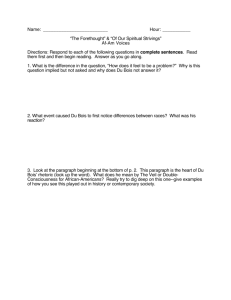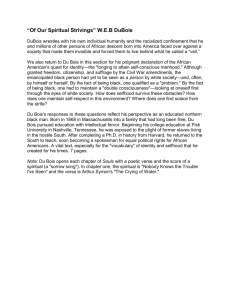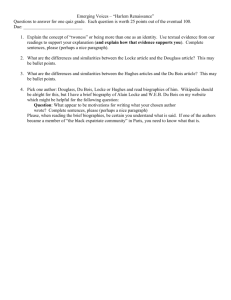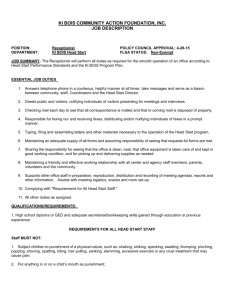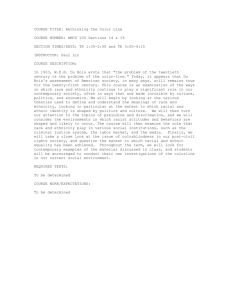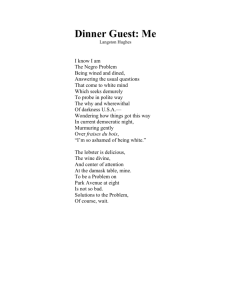Grade 11 ELA Module 2, Unit 1, Lesson 26
advertisement
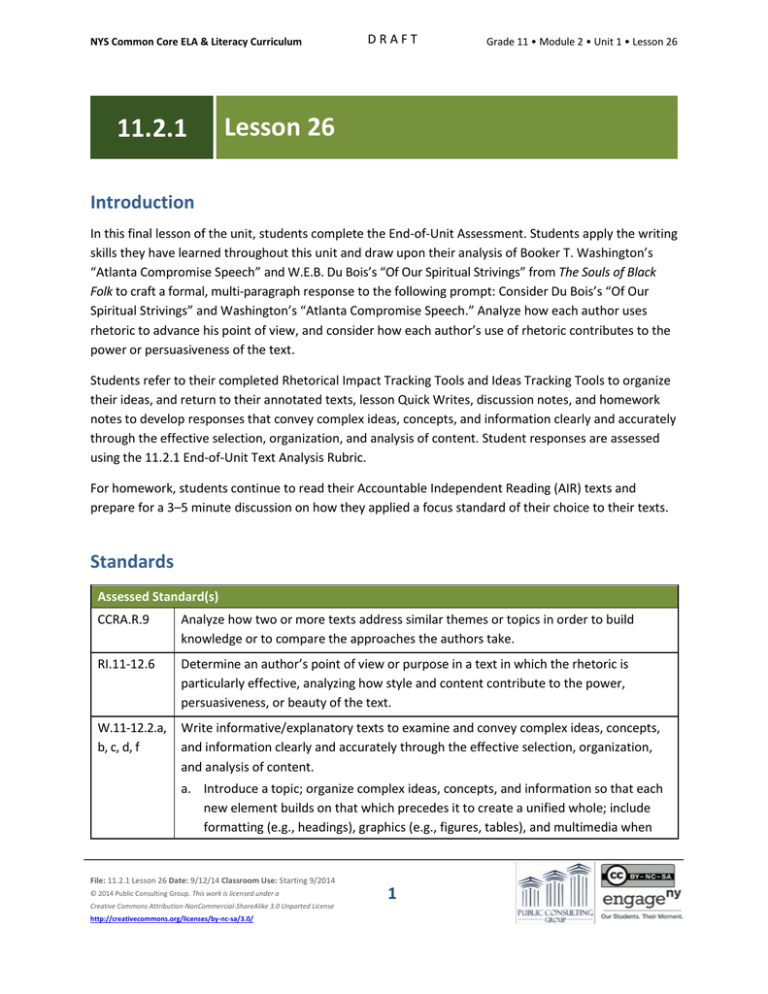
NYS Common Core ELA & Literacy Curriculum 11.2.1 DRAFT Grade 11 • Module 2 • Unit 1 • Lesson 26 Lesson 26 Introduction In this final lesson of the unit, students complete the End-of-Unit Assessment. Students apply the writing skills they have learned throughout this unit and draw upon their analysis of Booker T. Washington’s “Atlanta Compromise Speech” and W.E.B. Du Bois’s “Of Our Spiritual Strivings” from The Souls of Black Folk to craft a formal, multi-paragraph response to the following prompt: Consider Du Bois’s “Of Our Spiritual Strivings” and Washington’s “Atlanta Compromise Speech.” Analyze how each author uses rhetoric to advance his point of view, and consider how each author’s use of rhetoric contributes to the power or persuasiveness of the text. Students refer to their completed Rhetorical Impact Tracking Tools and Ideas Tracking Tools to organize their ideas, and return to their annotated texts, lesson Quick Writes, discussion notes, and homework notes to develop responses that convey complex ideas, concepts, and information clearly and accurately through the effective selection, organization, and analysis of content. Student responses are assessed using the 11.2.1 End-of-Unit Text Analysis Rubric. For homework, students continue to read their Accountable Independent Reading (AIR) texts and prepare for a 3–5 minute discussion on how they applied a focus standard of their choice to their texts. Standards Assessed Standard(s) CCRA.R.9 Analyze how two or more texts address similar themes or topics in order to build knowledge or to compare the approaches the authors take. RI.11-12.6 Determine an author’s point of view or purpose in a text in which the rhetoric is particularly effective, analyzing how style and content contribute to the power, persuasiveness, or beauty of the text. W.11-12.2.a, b, c, d, f Write informative/explanatory texts to examine and convey complex ideas, concepts, and information clearly and accurately through the effective selection, organization, and analysis of content. a. Introduce a topic; organize complex ideas, concepts, and information so that each new element builds on that which precedes it to create a unified whole; include formatting (e.g., headings), graphics (e.g., figures, tables), and multimedia when File: 11.2.1 Lesson 26 Date: 9/12/14 Classroom Use: Starting 9/2014 © 2014 Public Consulting Group. This work is licensed under a Creative Commons Attribution-NonCommercial-ShareAlike 3.0 Unported License http://creativecommons.org/licenses/by-nc-sa/3.0/ 1 NYS Common Core ELA & Literacy Curriculum DRAFT Grade 11 • Module 2 • Unit 1 • Lesson 26 useful to aiding comprehension. b. Develop the topic thoroughly by selecting the most significant and relevant facts, extended definitions, concrete details, quotations, or other information and examples appropriate to the audience’s knowledge of the topic. c. Use appropriate and varied transitions and syntax to link the major sections of the text, create cohesion, and clarify the relationships among complex ideas and concepts. d. Use precise language, domain-specific vocabulary, and techniques such as metaphor, simile, and analogy to manage the complexity of the topic. f. Provide a concluding statement or section that follows from and supports the information or explanation presented (e.g., articulating implications or the significance of the topic). L.11-12.1 Demonstrate command of the conventions of standard English grammar and usage when writing or speaking. L.11-12.2 Demonstrate command of the conventions of standard English capitalization, punctuation, and spelling when writing. Addressed Standard(s) W.11-12.9.b Draw evidence from literary or informational texts to support analysis, reflection, and research. b. Apply grades 11–12 Reading standards to literary nonfiction (e.g., “Delineate and evaluate the reasoning in seminal U.S. texts, including the application of constitutional principles and use of legal reasoning [e.g., in U.S. Supreme Court Case majority opinions and dissents] and the premises, purposes, and arguments in works of public advocacy [e.g., The Federalist, presidential addresses]”). Assessment Assessment(s) Student learning is assessed via a multi-paragraph response to the End-of-Unit Assessment. Students respond to the following prompt, citing textual evidence to support analysis and inferences drawn from the text. Consider Du Bois’s “Of Our Spiritual Strivings” and Washington’s “Atlanta Compromise Speech.” Analyze how each author uses rhetoric to advance his point of view, and consider how each author’s use of rhetoric contributes to the power or persuasiveness of the text. Student responses will be evaluated using the 11.2.1 End-of-Unit Text Analysis Rubric. File: 11.2.1 Lesson 26 Date: 9/12/14 Classroom Use: Starting 9/2014 © 2014 Public Consulting Group. This work is licensed under a Creative Commons Attribution-NonCommercial-ShareAlike 3.0 Unported License http://creativecommons.org/licenses/by-nc-sa/3.0/ 2 NYS Common Core ELA & Literacy Curriculum DRAFT Grade 11 • Module 2 • Unit 1 • Lesson 26 High Performance Response(s) A High Performance Response should: Identify Du Bois’s and Washington’s points of view (e.g., In “Of Our Spiritual Strivings,” Du Bois’s point of view is that African Americans can only “gain[] and perfect[] … liberty” (Du Bois, par. 8) by securing freedom, political power, and education. These ideals will allow African Americans to achieve true self-consciousness, or a unified identity that respects and values what African Americans have to offer the Nation. In his “Atlanta Compromise Speech,” Washington’s point of view is that African Americans should “better[] their condition” (Washington, par. 3) by focusing on achieving economic stability and self-reliance through participation in business and industry, rather than pursue social equality.). Analyze how each author’s use of rhetoric advances his point of view (see examples below). o Du Bois compares the story of the Israelites’ quest for the Promised Land of Canaan to African Americans’ search for complete liberty. This metaphor advances his point of view that African Americans need the “ideals” of freedom, political power, and education “melted and welded into one” (Du Bois, par. 12) in order to truly be free, by implying that Emancipation alone did not result in freedom for African Americans. Just as the persecuted Israelites journeyed long and far in search of the Promised Land, African Americans had to continue to search for freedom even after Emancipation. Du Bois further develops this metaphor in his description of education as “the mountain path to Canaan” (Du Bois, par. 8). Du Bois describes African Americans’ hard work climbing “[u]p the new path” (Du Bois, par. 9) and educating themselves. These “inches of progress” (Du Bois, par. 9) brought African Americans closer to achieving liberty as they gained “dawning self-consciousness, self-realization, [and] selfrespect” (Du Bois, par. 9); however, “Canaan” remained “always dim and far away” (Du Bois, par. 9). This suggests that African Americans were unable to find complete liberty by pursuing education alone. Rather, Du Bois believes that it is the combination of the ideals of freedom, education, and political power, “not singly, but together, not successively, but together” (Du Bois, par. 12), that will enable African Americans to finally achieve true self-consciousness, or a unified identity based on self-respect and self-knowledge. Fostering this “unifying ideal of race” will enable all Americans to “unite in human brotherhood.” Du Bois believes that this mutual cooperation and respect between African Americans and white Americans will finally bring about the complete liberty that African American have long sought. o Washington uses the allegory of a ship captain who, “lost at sea” (par. 3), listens to the surprising advice of another ship captain, throws his bucket down into the sea, and finds fresh river water. This allegory contributes to his point of view that African Americans should “better[] their condition” (Washington, par. 3) by staying in the South and developing skills they already have. Repeating the simple advice of the ship captain, Washington also advises African Americans to “‘[c]ast down [their] bucket where [they] are’” (par. 3), encouraging File: 11.2.1 Lesson 26 Date: 9/12/14 Classroom Use: Starting 9/2014 © 2014 Public Consulting Group. This work is licensed under a Creative Commons Attribution-NonCommercial-ShareAlike 3.0 Unported License http://creativecommons.org/licenses/by-nc-sa/3.0/ 3 NYS Common Core ELA & Literacy Curriculum DRAFT Grade 11 • Module 2 • Unit 1 • Lesson 26 them to focus on “common labour” (par. 4), a type of work they are already familiar with, in order to achieve economic stability for themselves and “the prosperity of the South” (par. 5), rather than focusing on politics and other social pursuits. Washington then repeats this same advice to the white members of his audience, advising them to also “‘[c]ast down [their] bucket where [they] are’… among the eight millions of Negroes whose habits you know” (par. 5). Washington’s repetition of the same phrase advances his point of view that white Americans and African Americans should rely upon each other and work together to achieve economic prosperity in the South. Consider how each author’s use of rhetoric contributes to the power or persuasiveness of his text (see examples below). o Du Bois’s allusion to Canaan contributes to the power of his text because it instills the struggle to achieve complete liberty with a sense of divine approval. By comparing African Americans to the Israelites, Du Bois stresses the righteousness and unwavering faith of African Americans, who, like the unjustly persecuted “wearied Israelites” (par. 6), continue striving for freedom against all odds. By comparing complete liberty in America to “a promised land of sweeter beauty” (Du Bois, par. 6), Du Bois emphasizes the magnificence of complete liberty, while simultaneously suggesting that freedom for African Americans is God’s will. Finally, Du Bois’s allusion to Canaan contributes to the power of his text because it imparts a sense of hope that however long their journey, African Americans will one day be completely free. o Washington’s use of the allegory of the ship “lost at sea” (Washington, par. 3) contributes to the persuasiveness of his point of view, because it suggests that the solution to the problem currently facing the South is not complex, but surprisingly straightforward. Just as the fresh water that the ship captain needed to save his thirsty passengers was easily within his reach, the solution Washington offers to the problem of the best course of action for African Americans and white Southerners to take in the years after Emancipation is right “’where [they] are’” (Washington, par. 3). African Americans can “better[] their condition” (Washington, par. 3) by forging relationships with white Southerners, and dedicating themselves to “the common occupations of life” (Washington, par. 4) with which they are already familiar. In turn, white Southerners can contribute to the prosperity of the South by relying upon and working with the same people that they have already relied upon for many years. Washington’s use of the allegory of the lost ship stresses that Southern economic prosperity, and the “higher good” (par. 10) of “social equality” (par. 9) that will eventually result from this, is a matter of African Americans and white Southerners uniting around shared economic interests. File: 11.2.1 Lesson 26 Date: 9/12/14 Classroom Use: Starting 9/2014 © 2014 Public Consulting Group. This work is licensed under a Creative Commons Attribution-NonCommercial-ShareAlike 3.0 Unported License http://creativecommons.org/licenses/by-nc-sa/3.0/ 4 NYS Common Core ELA & Literacy Curriculum DRAFT Grade 11 • Module 2 • Unit 1 • Lesson 26 Vocabulary Vocabulary to provide directly (will not include extended instruction) None.* Vocabulary to teach (may include direct word work and/or questions) None.* Additional vocabulary to support English Language Learners (to provide directly) None.* *Because this is not a close reading lesson, there is no specified vocabulary. However, in the process of returning to the text, students may uncover unfamiliar words. Teachers can guide students to make meaning of these words by following the protocols described in 1e of this document http://www.engageny.org/sites/default/files/resource/attachments/912_ela_prefatory_material.pdf. Lesson Agenda/Overview Student-Facing Agenda % of Lesson Standards & Text: Standards: CCRA.R.9, RI.11-12.6, L.11-12.1, L.11-12.2, W.11-12.2.a, b, c, d, f, W.11-12.9.b Text: The Souls of Black Folk by W.E.B. Du Bois, Chapter 1: “Of Our Spiritual Strivings,” “Atlanta Compromise Speech” by Booker T. Washington Learning Sequence: 1. 2. 3. 4. Introduction of Lesson Agenda Homework Accountability 11.2.1 End-of-Unit Assessment Closing 1. 2. 3. 4. 5% 10% 80% 5% Materials Copies of the 11.2.1 End-of-Unit Assessment for each student Student copies of the 11.2.1 End-of-Unit Text Analysis Rubric and Checklist (refer to 11.2.1 Lesson 5) Student copies of Rhetorical Impact Tracking Tools for W.E.B. Du Bois’s “Of Our Spiritual Strivings” and Booker T. Washington’s “Atlanta Compromise Speech” (refer to 11.2.1 Lesson 6) File: 11.2.1 Lesson 26 Date: 9/12/14 Classroom Use: Starting 9/2014 © 2014 Public Consulting Group. This work is licensed under a Creative Commons Attribution-NonCommercial-ShareAlike 3.0 Unported License http://creativecommons.org/licenses/by-nc-sa/3.0/ 5 NYS Common Core ELA & Literacy Curriculum DRAFT Grade 11 • Module 2 • Unit 1 • Lesson 26 Student copies of Ideas Tracking Tools for W.E.B. Du Bois’s “Of Our Spiritual Strivings” and Booker T. Washington’s “Atlanta Compromise Speech” (refer to 11.2.1 Lesson 2) Learning Sequence How to Use the Learning Sequence Symbol Type of Text & Interpretation of the Symbol 10% Percentage indicates the percentage of lesson time each activity should take. Plain text indicates teacher action. Bold text indicates questions for the teacher to ask students. Italicized text indicates a vocabulary word. Indicates student action(s). Indicates possible student response(s) to teacher questions. Indicates instructional notes for the teacher. no symbol Activity 1: Introduction of Lesson Agenda 5% Begin by reviewing the agenda and the assessed standards for this lesson: CCRA.R.9, RI.11-12.6, L.1112.1, L.11-12.2 and W.11-12.2.a, b, c, d, f. In this lesson, students complete the End-of-Unit Assessment, in which they analyze how Du Bois and Washington use rhetoric to advance their respective points of view, and consider how their rhetoric contributes to the power or persuasiveness of the texts. Students look at the agenda. Activity 2: Homework Accountability 10% Instruct students to take out their responses to the previous lesson’s homework assignment. (Prepare for the End-of-Unit Assessment by reviewing Washington’s “Atlanta Compromise Speech” and Du Bois’s “Of Our Spiritual Strivings.” Rewrite and expand your related notes and annotations. Also, note two instances in which each author’s use of rhetoric contributes to the power or persuasiveness of the text and come prepared to discuss these examples in the following lesson.) Instruct students to form pairs and discuss the examples of rhetoric they identified for the previous lesson’s homework. Student responses may include: o Washington repeats the phrase “[c]ast down your bucket” (Washington, par. 3, 5) in reference to his central allegory to both African-American and white Southerners. This repetition is persuasive because it creates a sense of unity, similarity, or shared experience between the two races, and encourages all Southerners to work together to help the South prosper economically. File: 11.2.1 Lesson 26 Date: 9/12/14 Classroom Use: Starting 9/2014 © 2014 Public Consulting Group. This work is licensed under a Creative Commons Attribution-NonCommercial-ShareAlike 3.0 Unported License http://creativecommons.org/licenses/by-nc-sa/3.0/ 6 NYS Common Core ELA & Literacy Curriculum o o DRAFT Grade 11 • Module 2 • Unit 1 • Lesson 26 Du Bois’s use of rhetorical questions throughout “Of Our Spiritual Strivings” contributes to the powerful nature of his text. For example, when describing African Americans’ contributions to American culture Du Bois asks, “Will America be poorer if she replace her brutal dyspeptic blundering with light-hearted but determined Negro humility? or her coarse and cruel wit with loving jovial good-humor?” (par. 12). Through this series of rhetorical questions, Du Bois exposes American cultural weaknesses, while offering up the cultural strengths of African Americans as a solution. Du Bois uses parallel structure to describe the desire of the African American man “to merge his double self into a better and truer self” (par. 4) without losing either identity. Using parallel structure, Du Bois writes, “He would not Africanize America, for America has too much to teach the world and Africa. He would not bleach his Negro soul in a flood of white Americanism, for he knows that Negro blood has a message for the world” (Du Bois, par. 4). This use of parallel structure contributes to the persuasiveness of the text by convincing readers that African Americans value both American culture as well as their own because they both have a “message for the world” or something to “teach the world” (Du Bois, par. 4), and they would sacrifice neither in developing “true self-consciousness” (Du Bois, par. 3). Lead a brief whole class discussion of student responses. Activity 3: 11.2.1 End-of-Unit Assessment 80% Explain to students that because it is a formal writing task, the End-of-Unit Assessment should include an introductory statement, well-organized ideas supported by the most significant and relevant evidence, and a concluding statement or section. Students should use appropriate and varied transitions and syntax to clarify relationships among complex ideas, and manage the complexity of the topic by using precise language, domain-specific vocabulary, and techniques such as metaphor and simile. Remind students to use this unit’s vocabulary, as well as proper grammar, capitalization, punctuation, and spelling in their responses to establish a formal style and objective tone. Instruct students to write a multi-paragraph response to the following prompt: Consider Du Bois’s “Of Our Spiritual Strivings” and Washington’s “Atlanta Compromise Speech.” Analyze how each author uses rhetoric to advance his point of view, and consider how each author’s use of rhetoric contributes to the power or persuasiveness of the text. Instruct students to take out their materials for the End-of-Unit Assessment, including their completed Tools, as well as their annotated text, lesson Quick Writes, discussion notes, and homework notes. Distribute and review the 11.2.1 End-of-Unit Text Analysis Rubric. Remind students to use the 11.2.1 End-of-Unit Text Analysis Rubric to guide their written responses. Ask students to use this unit’s vocabulary wherever possible in their written responses. File: 11.2.1 Lesson 26 Date: 9/12/14 Classroom Use: Starting 9/2014 © 2014 Public Consulting Group. This work is licensed under a Creative Commons Attribution-NonCommercial-ShareAlike 3.0 Unported License http://creativecommons.org/licenses/by-nc-sa/3.0/ 7 NYS Common Core ELA & Literacy Curriculum DRAFT Grade 11 • Module 2 • Unit 1 • Lesson 26 Display the prompt for students to see, or provide the prompt in hard copy. Transition to independent writing. Give students the remaining class period to write. Students independently answer the prompt using evidence from the text. See the High Performance Response at the beginning of this lesson. Consider encouraging those who finish early to read and revise their response using the 11.2.1 Endof-Unit Text Analysis Rubric and Checklist. Activity 4: Closing 5% Display and distribute the homework assignment. For homework, instruct students to continue to read their AIR texts through the lens of a focus standard of their choice and prepare for a 3–5 minute discussion of their texts based on that standard. Students follow along. Homework Continue reading your Accountable Independent Reading text through the lens of a focus standard of your choice and prepare for a 3–5 minute discussion of your text based on that standard. File: 11.2.1 Lesson 26 Date: 9/12/14 Classroom Use: Starting 9/2014 © 2014 Public Consulting Group. This work is licensed under a Creative Commons Attribution-NonCommercial-ShareAlike 3.0 Unported License http://creativecommons.org/licenses/by-nc-sa/3.0/ 8 DRAFT NYS Common Core ELA & Literacy Curriculum Grade 11 • Module 2 • Unit 1 • Lesson 26 11.2.1 End-of-Unit Assessment Text-Based Response Your Task: Rely on your reading and analysis of “Of Our Spiritual Strivings” by W.E.B. Du Bois and “The Atlanta Compromise Speech” by Booker T. Washington to write a well-developed response to the following prompt: Consider Du Bois’s “Of Our Spiritual Strivings” and Washington’s “Atlanta Compromise Speech.” Analyze how each author uses rhetoric to advance his point of view, and consider how each author’s use of rhetoric contributes to the power or persuasiveness of the text. Your response will be assessed using the 11.2.1 End-of-Unit Text Analysis Rubric. Guidelines Be sure to: Closely read the prompt Organize your ideas and evidence Develop a claim that responds directly to all parts of the prompt Cite strong and thorough textual evidence to support your analysis Follow the conventions of standard written English CCSS: CCRA.R.9, RI.11-12.6, W.11-12.2.a, b, c, d, f, L.11-12.1, L.11-12.2 Commentary on the Task: This task measures CCRA.R.9 because it demands that students: Analyze how two or more texts address similar themes or topics in order to build knowledge or to compare the approaches the authors take. This task measures RL.11-12.6 because it demands that students: Determine an author’s point of view or purpose in a text in which the rhetoric is particularly effective, analyzing how style and content contribute to the power, persuasiveness, or beauty of the text. This task measures W.11-12.2.a, b, c, d, f because it demands that students: Write informative/explanatory texts to examine and convey complex ideas, concepts, and information clearly and accurately through the effective selection, organization, and analysis of content. o o o Introduce a topic; organize complex ideas, concepts, and information so that each new element builds on that which precedes it to create a unified whole; include formatting (e.g. headings), graphics (e.g., figures, tables), and multimedia when useful to aiding comprehension. Develop the topic thoroughly by selecting the most significant and relevant facts, extended definitions, concrete details, quotations, or other information and examples appropriate to the audience’s knowledge of the topic. Use appropriate and varied transitions and syntax to link the major sections of the text, create File: 11.2.1 Lesson 26 Date: 9/12/14 Classroom Use: Starting 9/2014 © 2014 Public Consulting Group. This work is licensed under a Creative Commons Attribution-NonCommercial-ShareAlike 3.0 Unported License http://creativecommons.org/licenses/by-nc-sa/3.0/ 9 NYS Common Core ELA & Literacy Curriculum o o DRAFT Grade 11 • Module 2 • Unit 1 • Lesson 26 cohesion, and clarify the relationships among complex ideas and concepts. Use precise language, domain-specific vocabulary, and techniques such as metaphor, simile, and analogy to manage the complexity of the topic. Provide a concluding statement or section that follows from and supports the information or explanation presented (e.g., articulating implications or the significance of the topic). This task measures L.11-12.1 because it demands that students: Demonstrate command of the conventions of standard English grammar and usage when writing or speaking. This task measures L.11-12.2 because it demands that students: Demonstrate command of the conventions of standard English capitalization, punctuation, and spelling when writing. File: 11.2.1 Lesson 26 Date: 9/12/14 Classroom Use: Starting 9/2014 © 2014 Public Consulting Group. This work is licensed under a Creative Commons Attribution-NonCommercial-ShareAlike 3.0 Unported License http://creativecommons.org/licenses/by-nc-sa/3.0/ 10 NYS Common Core ELA & Literacy Curriculum DRAFT Grade 11 • Module 2 • Unit 1 • Lesson 26 11.2.1 End-of-Unit Text Analysis Rubric / (Total points) Criteria 4 – Responses at this level: 3 – Responses at this level: 2 – Responses at this level: 1 – Responses at this level: Content and Analysis Skillfully analyze how two or more texts address similar themes or topics. Accurately analyze how two or more texts address similar themes or topics. Inadequately or ineffectively analyze how two or more texts address similar themes or topics. Inaccurately analyze how two or more texts address similar themes or topics. Precisely determine an author’s point of view or purpose in a text in which the rhetoric is particularly effective; skillfully analyze how style and content contribute to the power, persuasiveness, or beauty of the text. Accurately determine an author’s point of view or purpose in a text in which the rhetoric is particularly effective; accurately analyze how style and content contribute to the power, persuasiveness, or beauty of the text. Partially determine an author’s point of view or purpose in a text in which the rhetoric is particularly effective; ineffectively analyze how style and content contribute to the power, persuasiveness, or beauty of the text. Inaccurately determine an author’s point of view or purpose in a text in which the rhetoric is particularly effective. Inaccurately analyze how style and content contribute to the power, persuasiveness, or beauty of the text. The extent to which the response analyzes how two or more texts address similar themes or topics in order to build knowledge or to compare the approaches the authors take. CCSS.ELA-Literacy.CCRA.R.9 Analyze how two or more texts address similar themes or topics in order to build knowledge or to compare the approaches the authors take. Content and Analysis The extent to which the response determines an author’s point of view or purpose in a text in which the rhetoric is particularly effective and analyzes how style and content contribute to the power, persuasiveness, or beauty of the text. CCSS.ELA-Literacy.RI.11-12.6 Determine an author’s point of view or purpose in a text in which the rhetoric is particularly effective, analyzing how style and content contribute to the power, persuasiveness, or beauty of the text. File: 11.2.1 Lesson 26 Date: 9/12/14 Classroom Use: Starting 9/2014 © 2014 Public Consulting Group. This work is licensed under a Creative Commons Attribution-NonCommercial-ShareAlike 3.0 Unported License http://creativecommons.org/licenses/by-nc-sa/3.0/ 11 NYS Common Core ELA & Literacy Curriculum Command of Evidence and Reasoning The extent to which the response thoroughly develops the topic through the effective selection and analysis of the most significant and relevant facts, extended definitions, concrete details, quotations, or other information and examples appropriate to the audience’s knowledge of the topic. DRAFT Grade 11 • Module 2 • Unit 1 • Lesson 26 Thoroughly and skillfully develop the analysis with the most significant and relevant facts, extended definitions, concrete details, quotations, or other information and examples appropriate to the audience’s knowledge of the topic. (W.11-12.2.b) Develop the analysis with significant and relevant facts, extended definitions, concrete details, quotations, or other information and examples appropriate to the audience’s knowledge of the topic. (W.11-12.2.b) Partially develop the analysis with weak facts, extended definitions, details, quotations, or other information and examples appropriate to the audience’s knowledge of the topic. (W.11-12.2.b) Minimally develop the analysis, providing few or irrelevant facts, extended definitions, details, quotations, or other information and examples inappropriate to the audience’s knowledge of the topic. (W.11-12.2.b) Skillfully introduce a topic; effectively organize complex ideas, concepts, and information so that each new element clearly builds on that which precedes it to create a unified whole. (W.11-12.2.a) Introduce a topic; organize complex ideas, concepts, and information so that each new element builds on that which precedes it to create a unified whole. (W.11-12.2.a) Lack a clear a topic; illogically arrange ideas, concepts, and information, failing to create a unified whole. (W.11-12.2.a) Skillfully and consistently use appropriate and varied transitions and syntax to link the major sections of the text, create cohesion, and clarify the relationships among complex ideas and concepts. (W.11-12.2.c) Consistently use appropriate and varied transitions and syntax to link the major sections of the text, create cohesion, and clarify the relationships among complex ideas and concepts. (W.11-12.2.c) Ineffectively introduce a topic; organize complex ideas, concepts, and information so that each new element partially builds on that which precedes it to create a loosely unified whole. (W.11-12.2.a) CCSS.ELA-Literacy.W.11-12.2 Write informative/explanatory texts to examine and convey complex ideas, concepts, and information clearly and accurately through the effective selection, organization, and analysis of content. CCSS.ELA-Literacy.W.11-12.2.b Develop the topic thoroughly by selecting the most significant and relevant facts, extended definitions, concrete details, quotations, or other information and examples appropriate to the audience’s knowledge of the topic. Coherence, Organization, and Style The extent to which the response introduces a topic and organizes complex ideas, concepts, and information so that each new element builds on that which precedes it to create a unified whole. CCSS.ELA-Literacy.W.11-12.2 Write informative/explanatory texts to examine and convey complex ideas, concepts, and information File: 11.2.1 Lesson 26 Date: 9/12/14 Classroom Use: Starting 9/2014 © 2014 Public Consulting Group. This work is licensed under a Creative Commons Attribution-NonCommercial-ShareAlike 3.0 Unported License http://creativecommons.org/licenses/by-nc-sa/3.0/ 12 Inconsistently use transitions, or use unvaried transitions and syntax to link the major sections of the text, creating limited cohesion or clarity in the relationships among complex ideas and concepts. (W.11-12.2.c) Use inappropriate and unvaried transitions and syntax to link the major sections of the text, creating incoherent or unclear relationships among complex ideas and concepts. (W.11-12.2.c) Rarely or inaccurately use precise language, domain-specific vocabulary, or any techniques such as metaphor, simile, and analogy to manage the NYS Common Core ELA & Literacy Curriculum clearly and accurately through the effective selection, organization, and analysis of content. CCSS.ELA-Literacy.W.11-12.2.a Introduce a topic; organize complex ideas, concepts, and information so that each new element builds on that which precedes it to create a unified whole; include formatting (e.g., headings), graphics (e.g., figures, tables), and multimedia when useful to aiding comprehension. Skillfully use precise language, domainspecific vocabulary, and techniques such as metaphor, simile, and analogy to manage the complexity of the topic. (W.11-12.2.d) Provide a concluding statement or section that clearly follows from and skillfully supports the information or explanation presented. (W.11-12.2.f) DRAFT Grade 11 • Module 2 • Unit 1 • Lesson 26 Use precise language, domain-specific vocabulary, and techniques such as metaphor, simile, and analogy to manage the complexity of the topic. (W.11-12.2.d) Provide a concluding statement or section that follows from and supports the information or explanation presented. (W.11-12.2.f) The extent to which the response uses appropriate and varied transitions and syntax to link the major sections of the text, create cohesion, and clarify the relationships among complex ideas and concepts. CCSS.ELA-Literacy.W.11-12.2.c Use appropriate and varied transitions and syntax to link the major sections of the text, create cohesion, and clarify the relationships among complex ideas and concepts. The extent to which the response includes and uses precise language, domain-specific vocabulary, and techniques such as metaphor, simile, and analogy to manage the complexity of the topic. CCSS.ELA-Literacy.W.11-12.2.d Use precise language, domain-specific vocabulary, and techniques such as metaphor, simile, and analogy to manage the complexity of the topic. File: 11.2.1 Lesson 26 Date: 9/12/14 Classroom Use: Starting 9/2014 © 2014 Public Consulting Group. This work is licensed under a Creative Commons Attribution-NonCommercial-ShareAlike 3.0 Unported License http://creativecommons.org/licenses/by-nc-sa/3.0/ 13 Inconsistently or ineffectively use precise language, domain-specific vocabulary, and techniques such as metaphor, simile, and analogy to manage the complexity of the topic. (W.11-12.2.d) Provide a concluding statement or section that loosely follows from and ineffectively supports the information or explanation presented. (W.11-12.2.f) complexity of the topic. (W.11-12.2.d) Provide a concluding statement or section that does not follow from or support the information or explanation presented. (W.11-12.2.f) NYS Common Core ELA & Literacy Curriculum DRAFT Grade 11 • Module 2 • Unit 1 • Lesson 26 The extent to which the response provides a concluding statement or section that follows from and supports the information or explanation presented (e.g., articulating implications or the significance of the topic). CCSS.ELA-Literacy.W.11-12.2.f Provide a concluding statement or section that follows from and supports the information or explanation presented (e.g., articulating implications or the significance of the topic). Control of Conventions The extent to which the response demonstrates command of the conventions of standard English grammar, usage, capitalization, punctuation, and spelling. Demonstrate skillful command of conventions with no grammar, usage, capitalization, punctuation, or spelling errors. Demonstrate command of conventions with occasional grammar, usage, capitalization, punctuation, or spelling errors that do not hinder comprehension. Demonstrate partial command of conventions with several grammar, usage, capitalization, punctuation, or spelling errors that hinder comprehension. CCSS.ELA-Literacy.L.11-12.1 CCSS.ELA-Literacy.L.11-12.2 Demonstrate command of the conventions of standard English grammar, usage, capitalization, punctuation, and spelling when writing or speaking. A response that is a personal response and makes little or no reference to the task or text can be scored no higher than a 1. A response that is totally copied from the text with no original writing must be given a 0. A response that is totally unrelated to the task, illegible, incoherent, blank, or unrecognizable as English must be scored as 0. File: 11.2.1 Lesson 26 Date: 9/12/14 Classroom Use: Starting 9/2014 © 2014 Public Consulting Group. This work is licensed under a Creative Commons Attribution-NonCommercial-ShareAlike 3.0 Unported License http://creativecommons.org/licenses/by-nc-sa/3.0/ 14 Demonstrate insufficient command of conventions with frequent grammar, usage, capitalization, punctuation, or spelling errors that make comprehension difficult. NYS Common Core ELA & Literacy Curriculum DRAFT Grade 11 • Module 2 • Unit 1 • Lesson 26 11.2.1 End-of-Unit Text Analysis Checklist Assessed Standards: Does my response… Content and Analysis ✔ Analyze how two or more texts address similar themes or topics? (CCRA.R.9) Determine an author’s point of view or purpose in a text? (RI.11-12.6) Analyze how style and content contribute to the power, persuasiveness, or beauty of the text? (RI.11-12.6) Command of Evidence and Reasoning Develop the response with the most significant and relevant textual evidence? (W.11-12.2.b) Coherence, Organization, and Style Introduce a topic? (W.11-12.2.a) Organize complex ideas, concepts, and information so that each new element builds on that which precedes it to create a unified whole? (W.11-12.2.a) Use appropriate and varied transitions and syntax to link the major sections of the text, create cohesion, and clarify the relationships among complex ideas and concepts? (W.11-12.2.c) Use precise language, domain specific vocabulary, and techniques such as metaphor, simile, and analogy to manage the complexity of the topic? (W.11-12.2.d) Provide a concluding statement or section that follows from and supports the explanation or analysis? (W.11-12.2.f) Demonstrate command of the conventions of standard English grammar, usage, capitalization, punctuation, and spelling? (L.11-12.1, L.11-12.2) Control of Conventions File: 11.2.1 Lesson 26 Date: 9/12/14 Classroom Use: Starting 9/2014 © 2014 Public Consulting Group. This work is licensed under a Creative Commons Attribution-NonCommercial-ShareAlike 3.0 Unported License http://creativecommons.org/licenses/by-nc-sa/3.0/ 15
